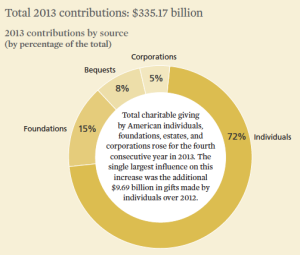Giving USA 2014, The Annual Report on Philanthropy that shows us, year after year, where the “big money” in nonprofit fundraising really is, has just been released. The highlights:
- Total estimated US charitable giving increased by 4.4% – to $335.17 billion
- Individual giving saw an increase of 4.2%
- Foundation giving increased by 8.7%
- Bequest giving increased by nearly 9%, and
- Giving by corporations declined by 2%
 Where should smart fundraisers be focusing their best efforts?
Where should smart fundraisers be focusing their best efforts?
Individuals
Individuals comprise 72% of overall giving. Focus in on yours with a laser like intensity. That means having a plan in place for stewarding new and loyal donors, creating a monthly giving program (and working it), communicating consistently and well through all channels, and developing your major donors.
Resources:
I’ve been saying it for years: Nonprofit donor retention | The cheapest way to fundraise
The best thing your nonprofit can do to increase individual giving (but you need to start now!)
How are you welcoming new donors? New Donor Welcome Kits | Your Next Gift Strategy
The most important component of major gifts fundraising? For fundraising success: Listen, don’t ask
A step-by-step four-week process for developing your monthly giving program: Monthly Giving | The Basics & More
Pay attention to Giving Tuesday, yes (Giving USA reported that contributions doubled for the social media movement in 2013), but ensure that your back end processes are in place to keep and grow those newly acquired donors. Consider enrolling in The Power of Thank You, my four-week stewardship training, this October.
Giving USA reports that online giving continues to see strong growth. Make sure that your organization has the basics in place. 11 Easy Steps to Growing Your Online Fundraising
Bequests
One of my earliest consulting clients was, to put it bluntly, a nightmare. Paralyzed with the worst case of founder’s syndrome I’ve ever seen, they were fortunate in one regard: they were able to keep their good work going thanks to the bequest gifts which arrived with great regularity — from the wheels put in motion 30 years earlier.
Bequest programs are clearly a no brainer.
In his webinar presented for Simple Development Systems members, Marketing Bequests: The Delicate Art of Asking for That Final Gift Tom Ahern noted the number one reason your donors don’t make a charitable bequest is that “It never occurred to me.” And global legacy expert Richard Radcliffe says “Without a clear “legacy vision” you will not give yourself the best chance to succeed. Without a vision there is little to grab hold of to enable a great donor experience.” There’s no need to over-think this one. Just put the idea in your donors’ heads, even if it’s something as simple as a signature line (example from subscriber Sam Vigil, Jr.).

The time to start is now.
Foundations
Since 2001, I’ve made it a point to build up a core base of support from small to mid-sized regional foundations. Why small to mid-sized foundations? Simple: their guidelines are typically not nearly as onerous as the larger foundations and they’re far easier to build relationships with. Even the best grantwriters might take a good three years to begin to see their efforts begin to bear fruit, but smart fundraisers know that foundation fundraising, just like individual giving takes a system and persistence.
Resources
4 Tips to ensure that this grant won’t be your last
A foundation director shares what resonates with funders
When it comes to grants, “trying” doesn’t cut it
Foundation prospect research doesn’t begin and end with The Foundation Center: 5 tips for becoming a foundation grants prospect research detective

















 I can’t wait to meet with you personally.
I can’t wait to meet with you personally.
Comments on this entry are closed.